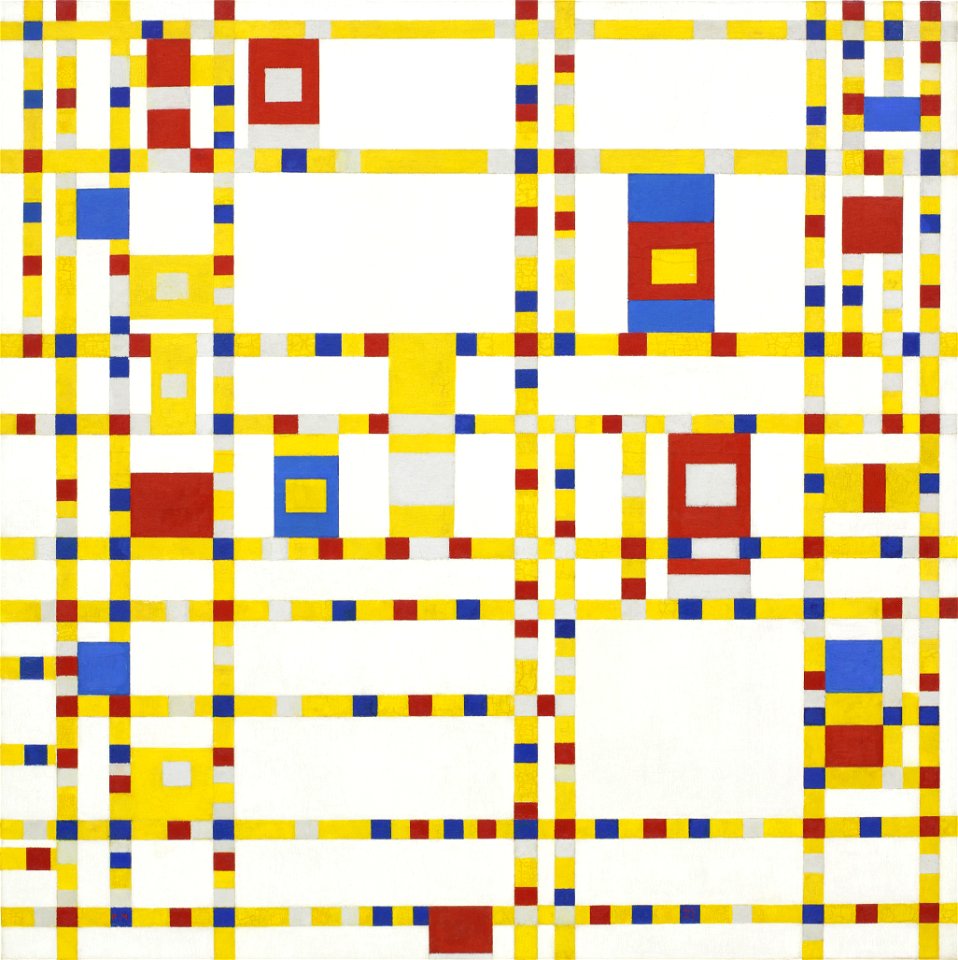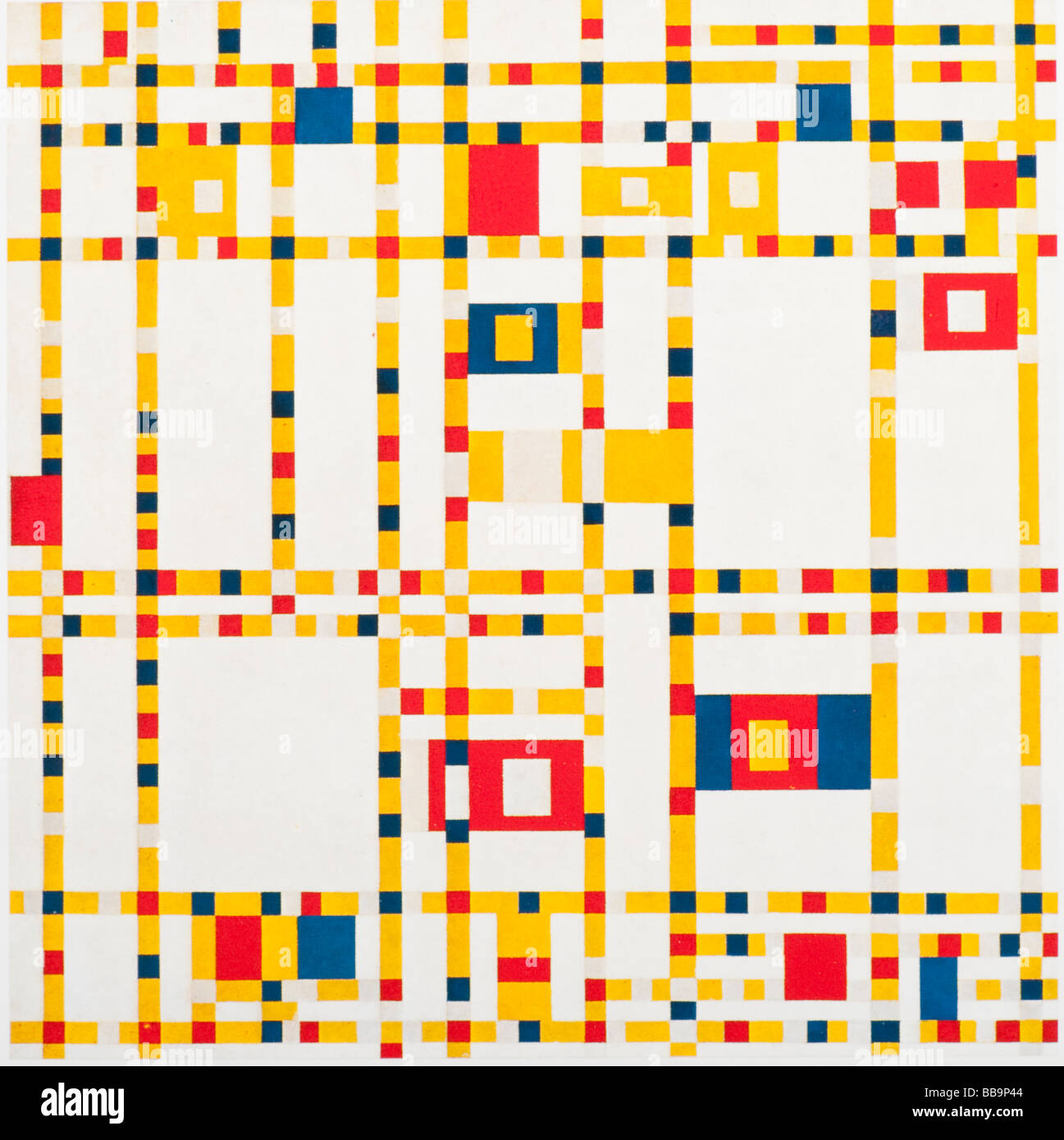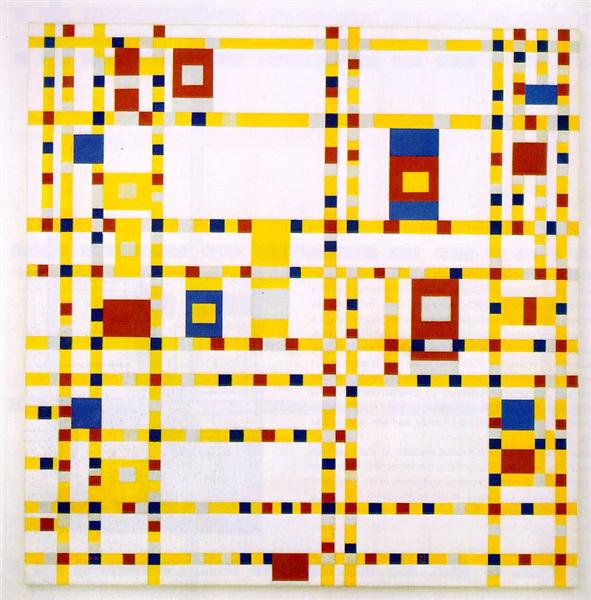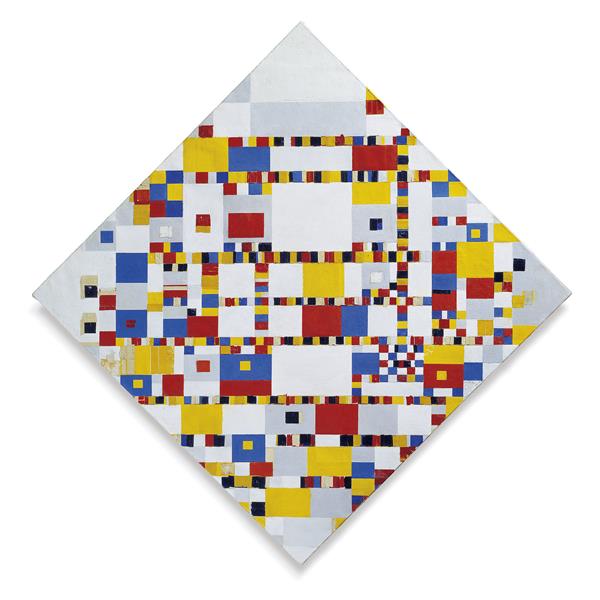
Piet Mondrian, 1942 Broadway Boogie Woogie Creazilla
Sebastian Smee May 12, 2021 Sometime in the 2000s, I became hooked on an online video game called "Pac-Mondrian." It was like "Pac-Man" — you gobbled dots while running from ghosts — but replaced.

Mondrian Broadway Boogie Woogie Howard Stanbury Flickr
From what Mondrian called the natural to the spiritual. Broadway Boogie Woogie. The controversial and virtually infinite space of the lines is transformed into a finite and lasting space with the unitary plane. It would, however, be a mistake to see this as calm in the sense of a total absence of inner tension.

Piet Mondrian Broadway Boogie Woogie Clashing Pride
Mondrian - Broadway Boogie Woogie John Chmaj 360 subscribers Subscribe 587 85K views 6 years ago From "Jazz Art / Art Jazz" concert, live improvisation to modern art. Recorded 5/20/17, East Shore.

Broadway Boogie Woogie 1943, Piet Mondrian 19721944, Trépanier Baer
Farm Near Duivendrecht. New York City I. Composition London. Composition II in Red, Blue, and Yellow. Composition: Checkerboard, Dark Colors. The Still Life with Gingerpot II. Composition C. Triangulated Farmhouse Facade with Blue Polder. Broadway boogie woogie 1943 - by Piet Mondrian.

Piet Mondrian BROADWAY BOOGIE WOOGIE MutualArt
• fig. 3 Piet Mondrian. Broadway Boogie Woogie. 1942 - 43. Oil on canvas, 50 × 50 in. (127 × 127 cm). The Museum of Modern Art, destructive/creative impulse of Mondrian's paintings extended to the space of his studio. Using colored squares, Mondrian turned his studio into a three-dimensional son between Mondrian's work and

Broadway Boogie Woogie Piet Cornelis Mondrian the largest gallery in the world
Given anonymously Ann Temkin: This painting is titled Broadway Boogie-Woogie. It was made by the Dutch-born artist Piet Mondrian in New York in 1942. Here, the horizontal and vertical lines of the painting are actually composed of rectangles and squares of red, blue, yellow, and white, and gray.

Piet Mondrian serigraph "Broadway BoogieWoogie"
Broadway Boogie Woogie The Dutch artist Piet Mondrian (1872-1944) was a pioneer in "abstraction." Each painting was worked and reworked, built layer by layer toward an equilibrium of form, color and surface. Born in Holland in 1878, Piet Mondrian painted traditional subjects in an increasingly abstract style.

Broadway Boogie Woogie di Piet Mondrian al Museo di Arte Moderna di New York City STATI UNITI D
Considered Mondrian's masterpiece, Broadway Boogie Woogie is a shimmering combination of multi-colored grid lines, complete with blocks of color, all in the primary palette. This piece represents another development in the unique style of the artist, which may have been the most profound.

Broadway BoogieWoogie Piet Mondrian Canvas Lab
Have you ever wondered what sparked Piet Mondrian's creation of "Broadway Boogie Woogie," that vibrant and enigmatic masterpiece? Take in the mesmerizing world of Mondrian's artistic evolution and the pulsating energy of New York City that infused life into his work. We'll go over the origins of Mondrian's iconic painting and what it symbolizes.

FichierPiet Mondrian, 1942 Broadway Boogie Woogie.jpg — Wikipédia
"Broadway Boogie Woogie" by Piet Mondrian was created after the artist moved to New York in 1940. Compared to his earlier work, the canvas is divided into many smaller squares. Although Mondrian spent most of his career creating highly abstract work not directly related to reality, this painting was inspired by the real-world.

Piet Mondrian Broadway Boogie Woogie Wall Art Blue Horizon Prints AU
Broadway Boogie-Woogie is the last painting Mondrian completed. In the early phases of its genesis, the two 1942 drawings in the Newman Collection, it still shows many points of coincidence with the painting preceded it, New York City I.In the preliminary studies rhythm of the painting is determined by the long lines of the grid, while other accents indicate the insertion of little bands of.

Broadway Boogie Woogie by Piet Mondrian on Auctions
Broadway Boogie-Woogie not only alludes to life within the city, but also heralds New York's developing role as the new center of modern art after World War II. Mondrian's last complete painting demonstrates his continued stylistic innovation while remaining true to his theories and format. Oil on canvas - The Museum of Modern Art, New York

Broadway Boogie Woogie Piet Mondrian encyclopedia of visual arts
Piet Mondrian Broadway Boogie Woogie 1942-43 On view MoMA, Floor 5, 512 The David Geffen Wing Mondrian arrived in New York in 1940, one of the many European artists who moved to the United States to escape World War II.

Broadway Boogie Woogie 194243 Piet Mondrian Piet mondrian painting, Piet mondrian, Mondrian
In "Broadway Boogie Woogie," Mondrian simplifies his elemental system further, dropping black and reducing red and blue to a series of dashes. Jeenah Moon for The New York Times But the truth.

Mondrian Sparked My Love of Painting The New York Times
Broadway Boogie Woogie is a painting by Piet Mondrian completed in 1943, after he had moved to New York in 1940. Compared to his earlier work, the canvas is divided into many more squares.

Victory Boogie Woogie, 1944 Piet Mondrian
Broadway Boogie Woogie Piet Mondrian, Broadway Boogie Woogie (1942-1943) While Broadway Boogie Woogie echoes Mondrian's experiments with grids and blocks of color, it is distinctively a step forward from his previous works such as Composition II in Red, Blue and Yellow.